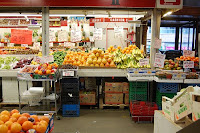10 Tips to Trim That Grocery Bill
| July 9, 2008 | Posted by Roshawn Watson under Uncategorized |
Stick To A List
It is so easy to drift off course and buy unintended items. In fact, grocery stores are designed for it. This is one reason why we must travel the entire store to obtain those few staple items we come in for. The longer we stay in there, the more likely we are to buy other things. Spare yourself the temptation by committing to sticking to a list. At least this way, you plan your purchases beforehand with your budget in mind.
Beware Prepared Meals & Precooked Entrees
By preparing meals yourself, one can generally save a lot compared to buying prepared meals. The price per pound for precooked entrees in many cases is significantly higher. One caution with this tip is that usually prepared meals and precooked entrees are a better substitute than eating out just because you are short for time. From a budget standpoint, if you have to choose between not so good (prepared foods) and bad (dining out), go with the not so good.
Reduce The Number Of Times You Go Grocery Shopping
By consolidating those trips to the supermarket into a single trip once a week, you can decrease the time you spend at the store thereby diminishing the likelihood that you will be tempted to drift off budget.
Know The Prices Of Your The Items On The List
This is a rule that I feel pretty passionate about. I was at a big box retailer and noticed that one of my favorite soups was marked up by twenty five percent. Now although I could have easily still purchased it, I was annoyed because I felt insulted. It was as if someone had said “let’s raise the price on that, no one will notice or care.” I noticed, and apparently so did others: after a few weeks, the price had gone back down and has remained unchanged ever since. In truth, the store had marked the item up more than many competitors, so on principle alone, I chose not to purchase it from them at the higher price. For bigger ticket items, this savings really add up.
Sales Items
Everything that has the word “sale” or “bargain” is not necessarily a deal. Don’t be conditioned to buy just because of ad words. Do comparative price analysis. Sometimes other products on the same shelf are cheaper. Brand name manufacturers sometimes pay hefty fees for premium product placing, so it is definitely worth comparing products. Additionally, even if you find a genuine deal (sometimes these are “loss leaders”), make sure you truly need or want the deal in the first place. Don’t be the advertiser’s puppet.
Per Unit Pricing
Looking at the unit pricing instead of just the total price can also save you a lot. Sometimes buying in bulk is cheaper, but other times it is more expensive. By looking at the unit price you can know for sure.
Consider Switching Brands
Sometimes you can get a great deal by switching brands. Not only can store and generic brands sometimes save you a ton, but other manufacturers sometimes have more competitive prices too. It is worth trying other products to see if the discount is worth it. If you cannot discriminate between the two products, why not choose the cheaper brand?
Don’t Shop While Hungry
Grocery stores will deliberately make sure that you are greeted with aroma’s of freshly baked goods and deserts. The goal is to make you hungry, so that you spend more money. It works. By eating or drinking a glass of water before you go shopping, you will be less susceptible to their delectable temptations.
Buy Bulk Items Carefully
Not only are bulk items sometimes more expensive, they are sometimes bad deals even if the unit prices are lower than smaller-packaged items. Perishable goods are a good example. If I purchased my perishable goods in bulk, they would likely go bad and the savings in many cases would be loss. It is important to keep YOUR family’s eating habits in mind while shopping for the deals.
Beware Checkout Lane Temptations
While you are stuck in a check out lane, you are a captive audience. This is where many stores try to gouge you one last time so that you make another unplanned purchase. One of my favorite ways to avoid this is by going at off-peak hours: that way you do not have to wait in lines. It is also a huge time-saver as well.
Lastly, if you like this post, please click here to get my Brand New eBook FREE and Propel it, Stumble it, and tag it on Delicious.
Copyright 2008, Roshawn Watson, Pharm.D. All Rights Reserved.
Related Posts
20 Ways To Dine Out Inexpensively
Copyright 2012, Roshawn Watson, Pharm.D., Ph.D. All Rights Reserved.








Very true. I am finding myself with same opinions mentioned above.- Supermarkets put kid's items like toys in middle racks so that kids can see them at their level easily instead of looking at higher levels and coax their parents into buying it. Not sure what can be done to prevent that unnecessary expense 🙂 . Dont take kids while shopping may be :-)- Some products are advertised at their lowest costs. Meaning what we see in ads is the cost of the lowest quality item. That is just to attract the customer to come to the shop. Once customer goes there hoping to get it, he will soon learn that the model of the item he wants is at a higher price. But now that he came there, he buys them anyways at a higher price.- Sometimes ads say – "Upto 50% discount". This is also just to attract the person to shop. Once customer goes there, he learns (and later forgets) that a. 50% is only for select items only (mostly useless items) b. For others it is no discount or much less discount c. The shop owner would have increased price first, then gave a discount to even out. So one ends up buying at same cost as if there were no discount. – Subtle are the Ads that revolve around special occasions like christmas. The ads chant to the sub concious minds of people as if, expensive Item X is not bought for the occasion, one is not living his / her life – which is not true actually I am from a different country than US, so not sure how many of the menitoned points applies in US.
All of your points seem relevant in the US. I loved your don't take kids with you tip 🙂 Research has shown that we spend more when we are with others while shopping.Thanks for sharing